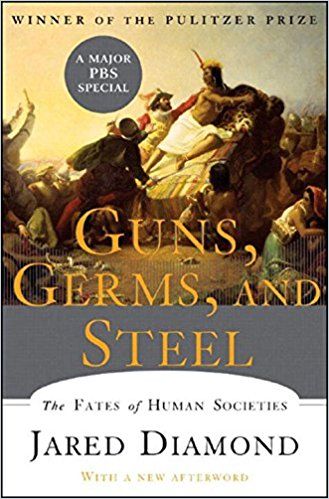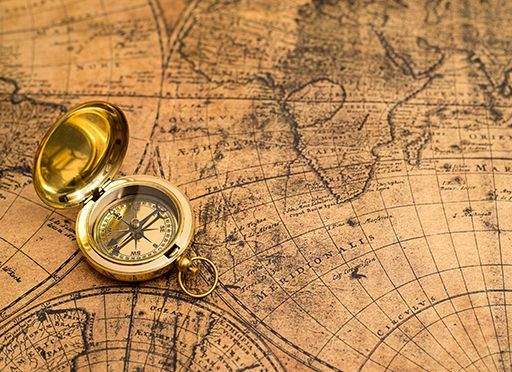Pulitzer Prize–winning historian Jared Diamond’s landmark book details the prime forces driving 13,000 years of human history.

Reframing History
In this New York Times bestseller (more than two million copies sold), Pulitzer Prize–winning historian Jared Diamond dismisses the notion that people, not places, account for inequality among nations and continents. Inequality, he teaches, stems from differences in geography and agricultural potential, not regional differences in human intellectual capacity – a racist belief many people cling to still.
Food production and societal complexity stimulate each other.Jared Diamond
In Diamond’s analysis, humanity’s adaptation of agriculture drove much of human history. The spread of agriculture allowed people to eat more nutritionally, women to have more children and laborers to expand their work beyond securing food. Farming indirectly encouraged the development of writing systems and the organizational predecessors of modern states. Along with guns and swords, Diamond reveals, germs became tools of conquest as Europeans infected vulnerable populations around the world with lethal diseases.
Competition
Food production and competition among societies drove the emergence of sedentary living in urbanizing centers of human populations. Sedentary living combined with societal rivalries to fuel conquest, political centralization and technological progress.
Diamond recounts how farming first emerged in the Fertile Crescent in Southwest Asia. Food production yields more than just food. After prehistoric times, no other region could match the Fertile Crescent’s technology, political complexity or arsenal of germs capable of infecting people elsewhere.
Food production was indirectly a prerequisite for guns, germs and steel.Jared Diamond
The Fertile Crescent is now largely infertile, having deforested its lands with farming, lumbering and overgrazing domesticated goats. Here, contrary to his thesis, Diamond blames people more than geography. Ecological suicide, he explains, shifted the balance of power. After epic deforestation, power shifted from Assyria, Babylon and Persia in the Fertile Crescent west to Greece and Rome.
Germs
Eurasia led the world in domestication of large mammals – including the horse, which became a weapon of war as early as 4000 BC – because it then featured the most wild creatures and lost the fewest to extinction. By comparison, in the Americas, most large candidates for animal domestication went extinct about 13,000 years ago. Over time, germs that caused animal diseases evolved into germs that plagued human beings with such illnesses as the flu, smallpox, measles and other diseases.
The major killers of humanity throughout our recent history…are infectious diseases that evolved from diseases of animals.Jared Diamond
The author’s historical lessons about germs prove especially illuminating. Exposure gave Europeans immunity, but European germs decimated the vulnerable people they encountered in the Americas, Australia, the Pacific Islands and South Africa. European germs killed far more Native Americans than European swords or guns.
Europeans explored New Guinea, where they encountered malaria and other tropical diseases for which they lacked immunity. Nearby Australia offered fewer new diseases, and the Europeans found land suitable for agriculture.
Continental Prosperity
Continents’ geographical position affected the growth of farming and technological innovation. For example, farming spread more slowly in Africa and the Americas than in Eurasia, which spans fewer latitudes and has fewer climate and terrain variations.
Humans are slowed by ecological and water barriers that crows can fly over.Jared Diamond
China’s major east-west rivers spread agriculture and technology. China exemplifies how inventiveness and receptivity to technology varies between societies. In 1433 AD, for example, a local political dispute led China to ban expeditions across the oceans, a prohibition which endured for centuries – until about 60 years before Christopher Columbus crossed the Atlantic.
Spreading Agriculture and Technology
Conquest diffused agriculture and technology by force. For example, Europeans colonizing sub-Saharan Africa had guns and other technology. Europeans gained these advantages faster than sub-Saharan Africans, whose region had fewer wild plants and animals for domestication and less land suited for agriculture. Diamond adds that the continent’s geographical barriers also slowed the spread of farming and innovation, as did its smaller population – now fewer than 700 million, compared with four billion in Eurasia.
The development and reception of inventions vary enormously from society to society on the same continent.Jared Diamond
During the Middle Ages, technology spread principally from Islamic societies to Europe. After 1500 AD, technology spread mainly from Europe to Islamic areas. People in the Fertile Crescent, Mexico, and possibly China invented writing systems independently. From these centers of food production, writing spread internationally through trade, religious observances and conquest.
Advantages
Bigger land masses spur technological advances. For example, China produced cast iron in approximately 500 BC and later invented gunpowder, paper, the wheelbarrow and the compass.
Other things being equal, more land and more people mean more competing societies and inventions, hence a faster pace of development.Jared Diamond
By emphasizing competition among societies, Diamond prioritizes capitalism over other economic models. He contrasts the political unification of China, for instance, with the political fragmentation of Europe. In China, local political decisions to halt innovation often became national policy. In Europe, if one state decided to adopt a useful innovation, adjacent states generally followed or faced being conquered or suffering economic obsolescence.
Review
Remarkably, Diamond has no political, moral or social ax to grind. He is as close to an objective historian as exists, and he builds a tapestry of quantifiable facts. Some of Diamond’s sections race by, but others read more slowly as he burrows deeply into minutiae. He seeks to reframe the history of conquest. In spelling out how landmass, wild animals and early technology provided some continents and populations with enormous advantages, Diamond gives every reader rich food for thought. This eloquent, wide-ranging, scientific exploration of progress will engage anyone seeking an original, compelling overview of world history.
This book attempts to provide a short history of everybody for the last 13,000 years.Jared Diamond
Jared Diamond’s other books include The Third Chimpanzee, Collapse, Upheaval, The World Until Yesterday, Why Is Sex Fun? and The Third Chimpanzee for Young People.








